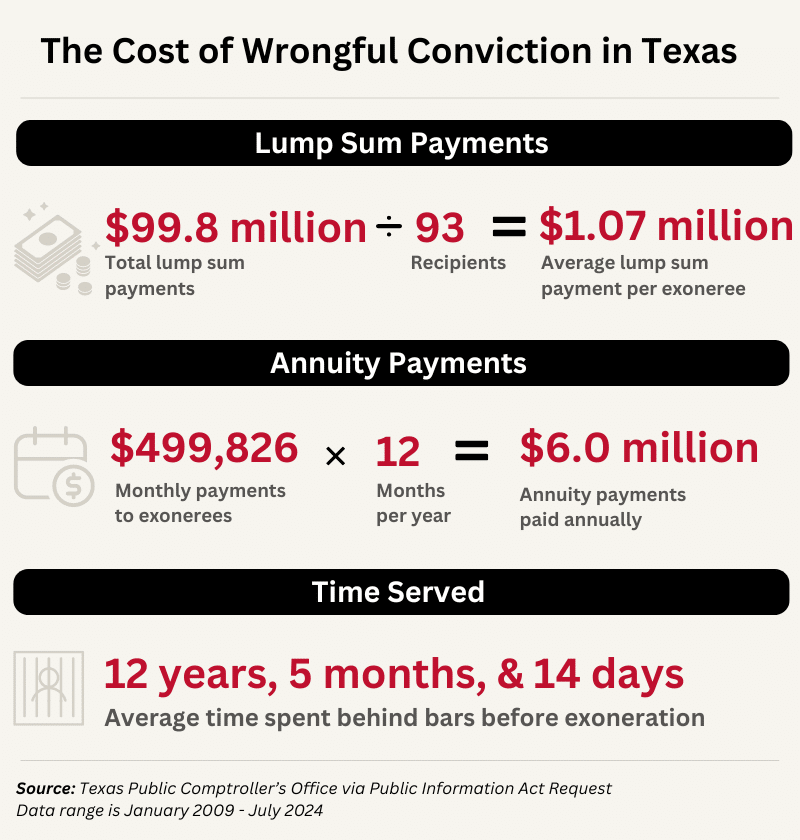Texas has paid almost $100 million in lump-sum payments since 2009 to 95 men and women who were wrongfully convicted, according to state records requested by Michael & Associates, a criminal defense law firm based in Austin, Texas, under the state’s Public Information Act.
The state also pays a monthly annuity to each qualified exoneree.
The tab for that currently stands at almost $500,000 per month, according to state records.
The compensation is due to the Tim Cole Act, a law enacted in 2009 that is named after a former Texas Tech University student. Cole died in prison in 1999 while serving a 25-year rape sentence. Almost a decade later, Cole was posthumously exonerated by DNA evidence.
October 2 is International Wrongful Convictions Day, a day to increase awareness of the causes and remedies of wrongful convictions and to recognize the financial, personal, social, and emotional costs for exonerees. To recognize this year’s theme, The Pursuit of Truth, Michael & Associates has used records from the Texas State Comptroller’s Office to examine the impact of the state’s laws to compensate exonerees.
What we’ll cover here
- Key Takeaways
- Lump-Sum Payments Totaled Almost $100 million
- Monthly Annuity Payments: $5,997,916.44 per year
- Years Incarcerated: 1,159 Years, 4 Months, and 3 Days
- Racial Breakdown
- More than One-Third of Wrongful Convictions Were in Dallas County
- Thousands More Cases Pending
- Who Was Tim Cole?
- Statistics: Compensation by State
- Ask the Experts
Key Takeaways

- 37 were wrongfully convicted in Dallas County, accounting for almost $53 million in lump-sum payments and over $294,000 in monthly annuity payments
- Of the 93 exonerees, 57 were Black, 25 were White, 10 were Hispanic, and one was Native American
- Currently, Texas’ compensation program is among the most generous in the nation
Lump-Sum Payments Totaled Almost $100 million
The Tim Cole Act, which became law in 2009, requires that exonerees are paid $80,000 per year of wrongful imprisonment, plus a monthly annuity payment to provide financial security for the future.
As of July 1, 2024, the state has paid $99,839,320.13 in lump-sum payments.
They’re also eligible for an additional $25,000 per year for every year they were wrongfully required to register as a sex offender or were on parole or other restrictive conditions after release from prison.
Is that enough to compensate for the years they’ve lost? It’s tough to say.
Only 31% of the Texas prisons are fully air-conditioned, and a 2022 study found that an average of 14 inmates a year die due to heat exposure. At least one inmate gave birth while incarcerated.
Some have been behind bars for decades, and when they’re finally released after the lengthy exoneration process, they are overwhelmed by new technology and find their career skills are outdated.
“Some men and women are incarcerated so long that they’ve lost loved ones while incarcerated and have no support or family structure intact to return to,” said Jessica Weinstock Paredes of the National Registry of Exonerees at the University of Michigan.
Michelle Moore, one of the founding members of Dallas County’s conviction integrity unit, cited widespread health and dental problems among exonerees due to poor health care for Texas prison inmates.
Moore said inmates got primary care, but there was no follow-up treatment.
Johnnie Lindsey, who spent almost 18 years in prison before he was exonerated, developed cancer while incarcerated. While he was given chemotherapy, Moore said that was the end of his treatment. He did not get routine screenings to ensure that the cancer didn’t return.
Lindsey received $1,820,000 in state compensation and a monthly annuity of $11,300. He died of liver cancer in January 2018.
At least one female exoneree in Travis County, Rosa Estela Jimenez, missed watching her children grow up. When she was convicted, Jimenez was seven months pregnant and had a one-year-old child. When she gave birth to a son after her conviction, she was only allowed to hold him for a total of five hours before he was placed in the state foster care system. Today, she is experiencing severe health problems and is awaiting a kidney transplant due to damage that doctors say is most likely the result of overuse of non-steroidal anti-inflammatory drugs like ibuprofen and naproxen during her time behind bars.
Despite situations like Jimenez’s, “Texas does much better in this area than most states,” says Jeffrey Gutman, a professor at George Washington University Law School who studies exoneree compensation in the U.S.
Larry Charles Fuller was the first exoneree to receive a lump-sum payment under the new law on Nov. 12, 2008. He spent almost 20 years in jail before he was released from prison on October 31, 2006.
Monthly Annuity Payments: $5,997,916.44 per year
In addition to the lump sum payments, the state also pays eligible exonerees a monthly annuity. Those payments total approximately $499,826 per month, according to Carol McCord, Senior Legal Counsel for Open Records for the Texas Comptroller of Public Accounts.
To calculate the annuity payments, the comptroller’s office says actuaries from the Social Security Administration estimate each exoneree’s life expectancy. The monthly payment is based on the lump sum payment they received — plus 5% compounded interest — divided by the amount of time each person is expected to live.
The payments end if an exoneree dies or is convicted of a felony. Fifteen of the 95 are either ineligible for a payment, are deceased, or the information was not provided.
Currently, Texas’ compensation program is among the most generous in the nation
Federal legislation was passed in 2015 that exempts wrongful conviction awards from federal taxation.
The exonerees are also entitled to additional non-monetary assistance, including:
- Tuition assistance
- Child support
- Medical assistance
- Health care assistance
- Employment assistance
- Re-entry/transitional services
Years Incarcerated: 1,159 Years, 4 Months, and 3 Days
Those receiving lump-sum payments spent as little as zero days in prison (Lenora Chaney was paid a lump-sum payment on behalf of her husband, Steven Chaney, who is deceased) or as long as 30 years, 11 months, and nine days (Rickey Dale Wyatt).
Records show that the highest payment – $2.4 million – went to Rickey Dale Wyatt, who spent 30 years, 11 months, and nine days in prison for a Dallas County aggravated rape he did not commit. Spencer’s 34 years behind bars makes him eligible for $2.7 million in compensation plus a monthly annuity.
Racial Breakdown
More than half of those who were wrongfully convicted were Black:
Of the 93 exonerees, 57 were Black, 25 were White, 10 were Hispanic, and one was Native American. This is consistent with national numbers. Research by the National Registry of Exonerations shows that more than half of all exonerees nationwide between 1989 and 2022 are Black, even though Black people account for roughly 13.6% of the U.S. population.
More than One-Third of Wrongful Convictions Were in Dallas County
The five largest counties in Texas account for 63 of 93 overturned convictions.
Though there are 95 names on the list of payments, there are technically only 93 exonerees. One inmate, Dejuan Anthony, was exonerated on two separate charges of failure to register as a sex offender and thus was entitled to two lump-sum payments. The final recipient was Lenora Chaney, who, as previously mentioned, received payment on her husband’s behalf.
Of the 93, 37 were wrongfully convicted in Dallas County, accounting for almost $53 million in lump-sum payments and over $294,000 in monthly annuity payments. At least 18 of these convictions – 17 of which involved Black men – happened between 1980 and 1987 under District Attorney Henry Wade. Wade, who passed away in 2001, never lost a case he personally tried.
Wade is best known as the defendant in the 1973 landmark Roe vs. Wade case and for securing a later-overturned murder conviction against Jack Ruby.
According to NBC News, as of 2008 (before the Tim Cole Act became law), 19 convictions tied to Wade were overturned. Questions remain about hundreds of other cases.
View Full Data by County
| County | Exonerees | Total Lump Sum Payment | Total Monthly Payment |
|---|---|---|---|
| Dallas | 37 | $54,418,184.22 | $ 294,690.56 |
| Harris | 16 | $11,913,333.33 | $ 54,331.94 |
| Bexar | 6 | $6,549,166.67 | $ 38,596.10 |
| Williamson | 5 | $5,746,249.99 | $ 41,006.21 |
| Tarrant | 4 | $5,821,406.39 | $ 31,197.24 |
| Lubbock | 3 | $1,434,583.33 | $ 1,015.28 |
| Waller | 2 | $351,666.66 | $ 1,568.03 |
| El Paso | 2 | $296,250.00 | $ 1,488.96 |
| Angelina | 2 | $1,627,500.00 | $ 6,478.48 |
| 2 | $923,333.33 | $ – | |
| Travis | 1 | 1,440,000.00 | $ – |
| Taylor | 1 | 463,333.33 | $ – |
| Sabine | 1 | $113,333.33 | $ 624.78 |
| Polk | 1 | $166,666.67 | $ 734.31 |
| Pecos | 1 | $936,666.68 | $ 6,796.55 |
| Nueces | 1 | $573,333.33 | $ 2,660.80 |
| McLennan | 1 | $194,583.33 | $ 1,111.00 |
| Henderson | 1 | 692,916.67 | $ – |
| Hale | 1 | $540,416.67 | $ 2,508.04 |
| Galveston | 1 | $46,666.67 | $ – |
| Ellis | 1 | $66,067.41 | $ 349.01 |
| Ector | 1 | 2,386,250.00 | $ – |
| Denton | 1 | $733,333.33 | $ 3,815.89 |
| Burnet | 1 | $423,333.33 | $ – |
| Brazoria | 1 | $1,457,828.79 | $ 7,597.09 |
| Bowie | 1 | $522,916.67 | $ 3,256.10 |
Thousands More Cases Pending
The total the state will pay only stands to increase. On August 29, 2024, Ben Spencer was exonerated in a Dallas courtroom after spending 34 years in prison for a crime he didn’t commit – the 1987 robbery and fatal beating of Jeffrey Young, a Dallas clothing store executive.
The Innocence Project of Texas estimates that 3,000 to 9,000 individuals are currently incarcerated in Texas prisons due to wrongful convictions.
According to data from the National Registry of Exonerations, Texas has the second-highest number of exonerations in the U.S., with 486. Only Illinois has more, with 555.
Who Was Tim Cole?
Ten years after Cole’s death, a Texas judge exonerated him posthumously, and Cole became a symbol of the flaws in the criminal justice system, particularly regarding wrongful convictions and racial biases. Texas Gov. Rick Perry pardoned Cole on March 1, 2010. After the Tim Cole Act was signed into law, state records show Cole’s family received a lump sum payment of $1,060,000
In addition to the lump-sum payments and monthly annuities, it established the Timothy Cole Advisory Panel on Wrongful Convictions to study the prevention of wrongful convictions across the state.
Statistics: Compensation by State
Eight states and Washington D.C. compensate inmates more than $50,000 for each year they were wrongfully incarcerated:
| State | Exoneree compensation |
| Washington, DC | $200,000 |
| Nevada | 1-10 years: $50,000 per year 1-20 years: $75,000 per year 21 or more years = $100,000 per year |
| Texas | $80,000 |
| Colorado | $70,000 |
| Kansas | $65,000 |
| Ohio | $56,752.361 |
| California | $51,110 |
| Connecticut | $49,314-$131,506 |
| Vermont | $30,000-$60,000 |
Currently, 12 states have no compensation statutes for wrongfully convicted people. The states are Alaska, Arizona, Arkansas, Delaware, Georgia, Kentucky, New Mexico, North Dakota, Pennsylvania, South Carolina, South Dakota, and Wyoming.
Ask the Experts
As part of the research, we spoke to several experts on wrongful convictions. Below are some of their comments.
-
William S. Bailey
Professor, University of Washington School of Law
What role does new technology play in helping those who were wrongfully convicted prove their innocence?
The criminal justice system long has been plagued with human error. Though it is not new, in the 1970’s Dr. Elizabeth Loftus proved the fallibility of memory and how easily it can be altered by the power of suggestion. Yet, for decades, judges and prosecutors stubbornly resisted allowing this expert testimony in cases involving eyewitness testimony. As a result, many innocent people were convicted by error prone eyewitnesses. It is only in recent years that this research finally has become widely used.
DNA is the single most effective means of proving wrongful convictions. New developments in amplifying minute amounts of DNA trace material have led to a number of exonerations. The CODIS database has been very helpful in this effort.
The landmark 2009 National Academy of Sciences report on forensic evidence did draw attention to all the bogus forensic evidence relied upon by the prosecution (e.g., bite marks). It is my sense that this has reduced the volume of junk science offered by the prosecution in years since. The NAS report also has made judges more aware of the perils of junk science.
But police agencies continue to place enormous emphasis on traditional methods of investigation (e.g., interviewing eyewitnesses), so the legal system continues to charge innocent people, particularly when the police overreach.
Racism remains as problematic as ever in wrongful convictions, truly appalling and highly resistant to improvement.
-
Jessica Weinstock Paredes
Denise Foderaro Research Scholar for The National Registry of Exonerations at the University of Michigan
What are some of the challenges dealing with reentry to society after exoneration?
As a former criminal defense attorney, I can tell you what the well-known challenges with reentry are for any incarcerated person. Releasees have physical, mental, emotional, and psychological trauma after being incarcerated. Integrating back into a society that has in many ways moved on without you, would be challenging enough, but those added burdens make the process even more difficult. It is very hard to find decent paying jobs once released. It can be very difficult to obtain housing. There is great stigma that comes from being an incarcerated person.
-
Jeffrey Gutman
Professor, George Washington University Law School
How does Texas stack up in terms of compensation for the wrongfully convicted?
Texas does much better than many states in this area as far as generosity of compensation.
-
Mike Ware
Executive Director of the Innocence Project of Texas
In your opinion, are these payments a fair way to make up for the years lost in prison?
They try to make up for lost time. It may seem unfair in some instances. That’s the problem with a one-size-fits-all statute.
-
Ben Michael
Founder, Michael & Associates

Rebecca Stumpf manages content research and editing for Michael & Associates. She is an award-winning journalist with 30+ years of experience working for daily newspapers. Her work has appeared on CNN, CNBC, Business Insider and DallasNews.com.

Rebecca Stumpf manages content research and editing for Michael & Associates. She is an award-winning journalist with 30+ years of experience working for daily newspapers. Her work has appeared on CNN, CNBC, Business Insider and DallasNews.com.




